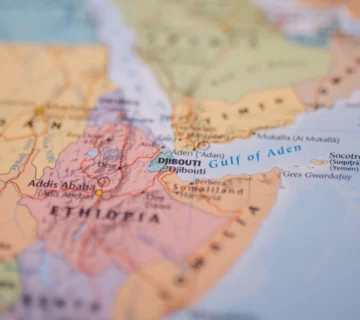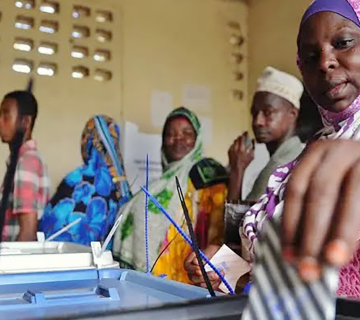Turmoil continues to define one of the world’s richest countries ahead of its December 23, 2018 presidential elections. DR Congo will have a chance to choose a new government that could change the course of its history that has been marked by different crises. The crises have, in turn, derailed the mineral-rich country from realizing its goal of becoming a strategic player both regionally and internationally.
The likely presidential aspirants are Jean-Pierre Bemba, Emmanuel Ramazani Shadary, Tryphon Kin-Kiey Mulumba, Vital Kamerhe, Moise Katumbi, and Felix Tshisekedi. Vital Kamerhe is a former president of the National Assembly, while Felix Tshikedi, the son of the former opposition activist, is currently the leader of the largest opposition party. Tryphon Kin-Kiey Mulumba’s participation surprises many because he had supported Kabila’s quest for a third term.
Jean-Pierre Bemba, an opposition and former rebel leader, has been excluded from the presidential race by the electoral commission of DR Congo on the grounds that the International Criminal Court (ICC) convicted him for bribing witnesses (witness tampering). Bemba had been accused by the ICC of crimes against humanity for murder, rape, and pillage committed in 2002 and 2003. The ICC released him when the majority of the judges ruled on his appeal. The Commission has likened this to corruption, which in DR Congo law, prohibits people from running for the presidency. It is still not clear if or how Bemba’s supporters will react to this move by the Commission to exclude him, his appeal notwithstanding.
Emmanuel Ramazani Shadary, a nominee of the ruling party, is one of President Joseph Kabila’s loyal followers. Shadary is unpopular among the citizens of DR Congo. Apart from this, he was sanctioned in 2017 by the European Union for alleged human rights violations. Kabila’s government has endorsed Shadary and it is clear that if he is to run for the presidency, then the regime might still continue to affirm its influence on the country.
Moise Katumbi, the former governor of Katanga Province and former ally of Kabila, has also been barred from entering the country. In 2016, he was convicted of real estate fraud and an arrest warrant has been issued. He will be arrested if he returns to the country.
Lumumba turned to the United Nations for help in restoring the sovereignty and territorial integrity of DR Congo. The United Nations failed to expel the Belgian troops and end Katanga’s secession. According to Gondola, this crisis resulted in the disintegration of the administrative system, and the collapse of the state.
The Second Republic began in 1965 when General Mobutu Sese Seko took control of the failing government state in a coup ousting President Kasavubu. However, what seemed as a state-building process turned out to be a long reign of dictatorship. Mobutu’s regime lasted for 32 years. He gained control over state resources and ruled through sponsorship from foreign states. As much as he got support from other countries and International Organizations such as the International Monetary Fund (IMF) in form of loans, he used the resources to develop the country. In 1997, the country got suspended from IMF and in terms of infrastructure, only 15 per cent of the roads were passable. Of note, these roads had been inherited from DR Congo’s colonizers, Belgium. The negative effects of Mobutu’s rule such as violence, that led to looting and destruction of infrastructure made it impossible to attract loans. This led to the weakening of formal economic activity and the collapse of banking services.
The Third Republic, which has been in existence since 1997 has been characterized by violence and instability. Between 1996 and 1997, the first ‘Congo War’ broke out and Mobutu’s long-time rule was toppled by the late Laurent-Desire Kabila with the help of Rwanda and Uganda. In 1998, a second war broke out with participation from various actors like Zimbabwe, Uganda, Rwanda, Chad, Angola, Hutu-aligned forces, Tutsi-aligned forces, Sudan, and Namibia, among others. While some took part in the war in support of Kabila, others sought to overthrow him. Ahere (2012) notes that the war ended with peace agreements such as the Lusaka Ceasefire Agreement (1999), Sun City Agreement (April 2002), Pretoria Agreement (July 2002), and Luanda Agreement (September 2002) that ultimately contributed to the Global and Inclusive Agreement of December 2002.
ultimate hope of owning them. This often led to destruction of property, annihilation of wildlife as well as loss of tourism to a region which is a leading destination for thousands of tourists across the globe. According to the 2009, Kenya Bureau of Statistics survey, it is alleged that the massive rate of population growth in Laikipia is a consequence of immigration of smallholder farmers from the south and pastoralists from the north in response to availability of land and associated resources that occurred with the sub-division if large-scale properties after Kenyan independence.
Dealing with such challenges will require a multi-agency approach. For the pastoral communities, investing in lifestyle shift in which the current large herds of indigenous cattle are replaced with smaller higher quality animals with greater returns will be more valuable. Additionally, the cattle should be reared for their commercial value rather than status symbol. The animals should also be scientifically branded with identifier electronic chips to deter rustling and stock theft. The pastoralist communities should be encouraged to embrace formal education that will inform alternative lifestyles other than cattle culture and learn to respect and appreciate other communities’ right to exist. It will also expose them to alternative source of livelihood. To the national and county governments, there is need for construction and improvement of existing infrastructure, hospitals, and water boreholes and livestock markets. Credible security systems and forces capable of deterring crimes and violations of privately owned property will also lead to a reduction in the conflict. The conservancy owners could erect strong and deterrent fences to keep the wildlife away from the small scale farmers’ crops and livestock. The county and national governments must establish a channel of dialogue to mitigate any conflict that could bring disharmony among the diverse communities living in Laikipia.
The Third Republic, which has been in existence since 1997 has been characterized by violence and instability. Between 1996 and 1997, the first ‘Congo War’ broke out and Mobutu’s long-time rule was toppled by the late Laurent-Desire Kabila with the help of Rwanda and Uganda. In 1998, a second war broke out with participation from various actors like Zimbabwe, Uganda, Rwanda, Chad, Angola, Hutu-aligned forces, Tutsi-aligned forces, Sudan, and Namibia, among others. While some took part in the war in support of Kabila, others sought to overthrow him. Ahere (2012) notes that the war ended with peace agreements such as the Lusaka Ceasefire Agreement (1999), Sun City Agreement (April 2002), Pretoria Agreement (July 2002), and Luanda Agreement (September 2002) that ultimately contributed to the Global and Inclusive Agreement of December 2002.
Janice Sanya, Research Department, the HORN Institute.



